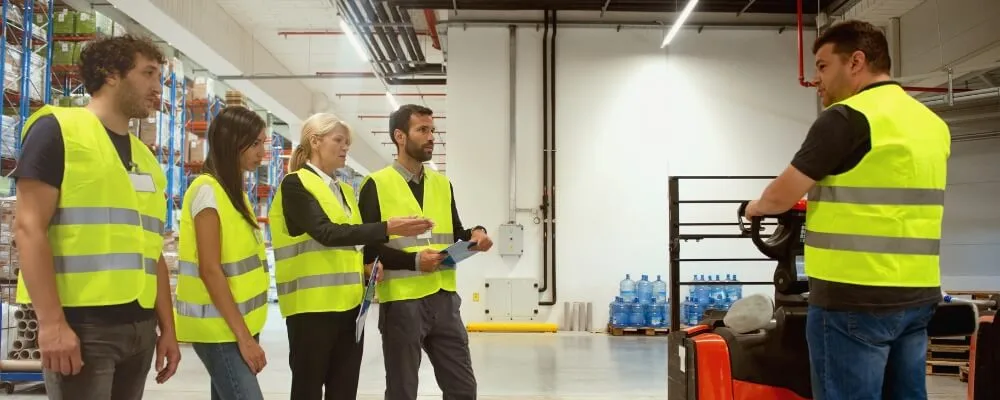Behavior-Based Safety (BBS) is a proactive approach to enhancing workplace safety by focusing on employees’ behaviors and the underlying factors influencing them. This comprehensive guide delves into the intricacies of BBS, outlining its seven pivotal steps, the significance of training, and strategies for successful implementation.
We’ll also provide insights on evaluating the effectiveness of a BBS program and offer real-world examples to illustrate its practical applications. Whether you’re new to BBS or seeking to refine your existing program, this guide offers a holistic overview to ensure a safer work environment.
What Is Behavior Based Safety (BBS)?
Behavior-Based Safety (BBS) is an approach to safety management that focuses on workers’ behavior as the cause of most work-related injuries and accidents. The primary objective of BBS is to identify and modify unsafe behaviors to prevent accidents and injuries in the workplace. Here’s a more detailed breakdown of BBS:
- Foundation on Observation: BBS is based on direct observation of workers performing their tasks. These observations help identify both safe and unsafe behaviors.
- Feedback Mechanism: Once observations are made, feedback is provided to the workers. This feedback is constructive and aims to reinforce safe behaviors and correct unsafe ones.
- Employee Involvement: BBS heavily involves employees at all levels. It’s not just a top-down approach; workers often participate in safety observations and provide feedback to their peers.
- Focus on Behavior: Instead of solely focusing on the conditions of the workplace, BBS emphasizes the importance of workers’ behavior. The belief is that by changing unsafe behaviors, the likelihood of accidents can be significantly reduced.
- Data-Driven: BBS relies on data collection and analysis. By tracking and analyzing unsafe behaviors, organizations can identify trends and areas of concern, allowing for targeted interventions.
- Positive Reinforcement: Instead of using punitive measures for unsafe behaviors, BBS often employs positive reinforcement to encourage safe behaviors. This can include recognition, rewards, or other incentives.
- Continuous Improvement: BBS is not a one-time initiative. It’s an ongoing process that requires regular observations, feedback, and adjustments based on the data collected.
- Cultural Change: Over time, the goal of BBS is to instill a culture of safety where workers are proactive about their safety and the safety of their peers.
Critics of BBS argue that it can sometimes place too much blame on individual workers without addressing systemic issues or workplace conditions that might contribute to unsafe behaviors. However, when implemented correctly and as part of a comprehensive safety program, BBS can be an effective tool for reducing workplace accidents and injuries.

7 Steps In the Behavior-Based Safety Process
Behavior-Based Safety (BBS) is a systematic process used in workplace safety management to reduce accidents and incidents by focusing on employee behavior. While there can be variations in the specific steps and methods used in BBS programs, here are seven common steps in the BBS process:
1. Developing the Problem Statement
The first step in the BBS process is to define the safety challenges or concerns within the organization clearly. This involves a comprehensive understanding of the specific issues, incidents, or patterns that indicate a safety problem. By articulating these concerns in a clear problem statement, the organization sets the stage for targeted interventions and ensures that everyone is aligned on the primary safety objectives.
2. Selecting the Problem Behaviours
After defining the overarching problem, the focus shifts to identifying the specific behaviors contributing to these safety challenges. This could range from actions like not wearing safety gear to more subtle behaviors like ignoring safety protocols due to time pressures. Pinpointing these behaviors is crucial as it allows the organization to address the root causes of safety incidents.
3. Identifying the Critical Behaviours
Within the range of problem behaviors, some will have a more significant impact on safety outcomes than others. This step involves distinguishing which behaviors, if changed, would have the most substantial positive effect on safety. These “critical behaviors” become the primary focus of intervention efforts.
4. Identifying Antecedents and Consequences Related to the Problem Behaviours
For every behavior, there are triggers (antecedents) that prompt it and outcomes (consequences) that reinforce or discourage it. By understanding what drives and reinforces unsafe behaviors, organizations can develop strategies to modify or replace these triggers and outcomes, making safe behavior more likely.
5. Designing and Implementing Interventions
With a clear understanding of the problem behaviors and their drivers, the next step is to design interventions that promote safe behaviors. These interventions can range from training programs and awareness campaigns to changes in work processes or the introduction of new safety equipment. The key is to ensure that these interventions specifically address the identified critical behaviors and their antecedents and consequences.
6. Validating the Effectiveness of Interventions
Once interventions are in place, it’s essential to assess their effectiveness. This involves monitoring and evaluating whether the interventions are leading to the desired changes in behavior. Feedback mechanisms, such as safety observations and employee surveys, can provide valuable insights into the interventions’ impact.
7. Measuring Outcomes of Interventions
The final step is to measure the tangible outcomes resulting from the implemented interventions. This goes beyond just tracking behavior changes; it involves monitoring key safety metrics like accident rates, near misses, and injury frequencies. By assessing these outcomes, organizations can determine the overall success of the BBS process and make necessary adjustments for continuous improvement.

Behavior-Based Safety (BBS) Training
Behavior Based Safety (BBS) training is designed to educate employees about the principles of BBS and equip them with the skills to identify, analyze, and modify unsafe behaviors in the workplace. The training typically covers the following components:
1. Introduction to BBS
- Definition and principles of BBS.
- The importance of focusing on behavior as a primary factor in workplace accidents.
- Overview of the BBS process.
2. Observation Techniques
- How to observe workers without being intrusive.
- Identifying safe and unsafe behaviors.
- The importance of unbiased observations.
3. Feedback Skills
- How to provide constructive feedback to peers.
- The importance of positive reinforcement.
- Techniques for addressing unsafe behaviors without assigning blame.
4. Data Collection and Analysis
- How to record observations.
- Analyzing data to identify trends and areas of concern.
- Using data to drive safety initiatives and interventions.
5. Role of Management
- Management’s role in supporting and promoting BBS.
- How management can set the tone for a safety culture.
- The importance of management’s commitment to the BBS process.
6. Employee Involvement
- Encouraging active participation from all employees.
- The role of safety committees or BBS teams.
- How employees can contribute to the continuous improvement of the BBS process.
7. Case Studies
- Real-life examples of how BBS has been implemented and the results achieved.
- Lessons learned from successful and unsuccessful BBS initiatives.
8. Continuous Improvement
- The importance of regularly reviewing and refining the BBS process.
- Techniques for keeping the BBS process fresh and engaging for employees.
9. Addressing Challenges
- Common challenges faced when implementing BBS.
- Strategies for overcoming resistance or skepticism.
10. Action Planning
- Developing a plan for implementing or improving BBS in the workplace.
- Setting goals and milestones.
- Identifying resources and support needed.
BBS training can be delivered in various formats, including classroom training, online courses, workshops, and on-the-job training. The training should be interactive, with opportunities for participants to practice observation and feedback skills, engage in group discussions, and work on action plans.
It’s essential that BBS training is not a one-time event. Refresher courses, ongoing coaching, and continuous feedback are crucial to ensure that the principles of BBS are ingrained in the workplace culture and that employees remain engaged in the process.

Implementing a Successful Behavior-Based Safety Program
Implementing a successful Behavior-Based Safety (BBS) program requires a systematic approach, commitment from all levels of the organization, and continuous monitoring and improvement. Here’s a step-by-step guide to help you implement a successful BBS program:
1. Management Commitment
- Ensure that top management is fully committed to the BBS program. Their support and involvement are crucial for the program’s success.
- Allocate necessary resources, including time, budget, and personnel, to support the program.
2. Establish a BBS Steering Committee
- Form a committee comprising representatives from management, safety professionals, and frontline employees.
- This committee will oversee the implementation, monitor progress, and make necessary adjustments to the program.
3. Define Clear Objectives
- Determine what you want to achieve with the BBS program, such as reducing accidents, improving safety culture, or increasing employee engagement in safety.
- Set measurable goals and key performance indicators (KPIs) to track progress.
4. Conduct Baseline Assessments
- Assess the current safety culture and performance to understand where improvements are needed.
- Collect data on current accident rates, near misses, and unsafe behaviors.
5. Develop Observation and Feedback Processes
- Train selected employees to conduct safety observations.
- Establish a process for providing constructive feedback to employees based on these observations.
- Ensure that the feedback process is non-punitive and focuses on positive reinforcement.
6. Employee Training and Engagement
- Provide training to all employees on the principles of BBS and their role in the program.
- Encourage active participation and create opportunities for employees to be involved in safety observations, feedback sessions, and safety committees.
7. Data Collection and Analysis
- Develop a system for collecting and analyzing data from safety observations.
- Regularly review this data to identify trends, areas of concern, and opportunities for improvement.
8. Communication
- Keep all employees informed about the program’s progress, successes, and challenges.
- Use various communication channels, such as safety meetings, newsletters, bulletin boards, and intranet sites.
9. Positive Reinforcement
- Recognize and reward safe behaviors and contributions to the BBS program.
- This can include verbal recognition, certificates, or other incentives.
10. Continuous Improvement
- Regularly review and adjust the BBS program based on feedback and data.
- Conduct periodic assessments to measure progress towards the program’s objectives.
11. Address Challenges Proactively
- Be prepared for resistance or skepticism from some employees. Address their concerns openly and provide information to alleviate any misconceptions.
- Ensure that the program doesn’t become solely focused on individual behaviors, neglecting systemic or environmental factors that contribute to unsafe conditions.
12. External Validation
- Consider bringing in external safety professionals or consultants to review the program and provide feedback.
- Benchmark your program against industry best practices or similar organizations.
13. Celebrate Successes
- Recognize and celebrate milestones and achievements in the BBS program.
- Sharing success stories can boost morale and reinforce the importance of the program.
Remember, the key to a successful BBS program is consistency, commitment, and a genuine focus on improving safety culture. It’s not just about reducing accidents but creating an environment where safety is a shared responsibility and a core value.

How Do I Know That the BBS Program Is Working
Determining the effectiveness of a Behavior Based Safety (BBS) program requires a combination of quantitative and qualitative measures. Here are some indicators and methods to assess whether your BBS program is working:
1. Reduction in Incidents and Accidents
- Track the number of workplace accidents, near misses, and incidents before and after implementing the BBS program. A decrease in these numbers can indicate the program’s effectiveness.
2. Safety Metrics
- Monitor key safety metrics such as Lost Time Injury Frequency Rate (LTIFR), Total Recordable Injury Frequency Rate (TRIFR), and Days Away, Restricted or Transferred (DART) rate. Improvements in these metrics can suggest a successful BBS program.
3. Observation Data
- Analyze the data from safety observations. An increase in safe behaviors and a decrease in unsafe behaviors can indicate that employees are adopting safer practices.
4. Employee Engagement
- Conduct surveys or feedback sessions to gauge employee engagement with the BBS program. High levels of participation and positive feedback can indicate that the program is resonating with employees.
5. Safety Culture Assessment
- Assess the overall safety culture in the organization. This can be done through surveys, focus groups, or interviews. A shift towards a more proactive and positive safety culture can indicate the program’s success.
6. Feedback Mechanisms
- Ensure there’s a robust system for employees to provide feedback on the BBS program. If employees are actively using this system and the feedback is generally positive, it’s a good sign.
7. Training and Refresher Courses
- Monitor attendance and engagement in BBS training sessions. High attendance and active participation can indicate that employees value the program.
8. Management Support
- Assess the level of support from management. If management is actively involved and supportive of the BBS program, it’s more likely to be effective.
9. Continuous Improvement
- Review the BBS program regularly to identify areas of improvement. If the program is continuously evolving based on feedback and data, it’s a sign that it’s being actively managed and is likely effective.
10. External Audits or Assessments
- Consider bringing in external safety professionals to assess the BBS program’s effectiveness. An outsider’s perspective can provide valuable insights and validate the program’s success.
11. Employee Turnover and Satisfaction
- Monitor employee turnover rates and conduct exit interviews. If employees mention safety concerns as a reason for leaving, it might indicate issues with the BBS program. Conversely, if employees express satisfaction with the safety culture, it’s a positive sign.
12. Benchmarking
- Compare your organization’s safety performance with industry benchmarks or similar organizations. If your organization is performing at or above industry standards, it can indicate the effectiveness of the BBS program.
Remember, no single indicator can provide a complete picture of the BBS program’s effectiveness. It’s essential to use a combination of measures and regularly review and adjust the program based on feedback and data.

Different Behavior-Based Safety (BBS) Examples
Behavior-Based Safety (BBS) is a proactive approach to managing safety by focusing on the behaviors of individuals. Here are some real-world examples of BBS in action:
Safety Observations:
- Scenario: In a manufacturing plant, trained observers regularly walk the production floor to observe workers performing their tasks.
- BBS Application: Observers note both safe and unsafe behaviors, such as proper use of personal protective equipment (PPE) or bypassing safety guards. Feedback is then provided to the workers, and data is collected for analysis.
Feedback Cards:
- Scenario: In a construction site, workers are given feedback cards to fill out when they observe a colleague performing a task safely or unsafely.
- BBS Application: These cards are then reviewed in weekly safety meetings, allowing for positive reinforcement of safe behaviors and discussions on how to correct unsafe ones.
Peer-to-Peer Feedback:
- Scenario: In an office setting, employees are encouraged to provide immediate feedback to their peers if they notice unsafe behaviors, such as leaving trip hazards or not following ergonomic guidelines.
- BBS Application: This immediate feedback helps in real-time correction of behaviors and fosters a culture where everyone looks out for each other’s safety.
Safety Scoreboards:
- Scenario: In a warehouse, a scoreboard displays the number of days without an accident and highlights specific safe behaviors observed during the week.
- BBS Application: The scoreboard serves as a visual reminder of the importance of safety and provides positive reinforcement for safe behaviors.
Safety Incentive Programs:
- Scenario: A chemical processing plant offers monthly rewards to teams or departments that demonstrate the highest percentage of safe behaviors.
- BBS Application: By focusing on rewarding safe behaviors (rather than just the absence of accidents), the plant promotes proactive safety measures.
Near-Miss Reporting:
- Scenario: In a hospital, staff members are encouraged to report near misses or situations where an accident could have occurred but didn’t.
- BBS Application: By analyzing these near misses, the hospital can identify potential hazards and address them before they lead to actual accidents.
Safety Role-Playing:
- Scenario: In a retail store, employees participate in role-playing exercises where they act out scenarios involving potential safety risks, such as spills or lifting heavy objects.
- BBS Application: These exercises allow employees to practice safe behaviors in a controlled environment and receive feedback on their performance.
Safety Behavior Audits:
- Scenario: In a mining operation, external safety consultants conduct periodic audits to observe and evaluate workers’ behaviors in relation to established safety protocols.
- BBS Application: These audits provide an unbiased view of safety behaviors and offer recommendations for improvement.
Interactive Safety Training:
- Scenario: In a logistics company, drivers participate in interactive training sessions where they are presented with various road scenarios and must choose the safest course of action.
- BBS Application: This training reinforces safe driving behaviors and allows drivers to learn from their mistakes in a risk-free environment.
Safety Behavior Surveys:
- Scenario: In a research laboratory, employees are periodically surveyed about their own safety behaviors and their perceptions of their colleagues’ behaviors.
- BBS Application: The survey data provides insights into areas where safety behaviors can be improved and helps identify potential barriers to safe behavior.
These examples illustrate the diverse applications of BBS across various industries and settings. The common thread is the focus on observing, analyzing, and modifying behaviors to enhance safety.
Conclusion
In conclusion, Behavior-Based Safety (BBS) stands as a pivotal approach in the realm of workplace safety, emphasizing the importance of understanding and modifying employee behaviors. By adopting a systematic process, offering comprehensive training, and continuously evaluating its effectiveness, organizations can significantly reduce workplace accidents and foster a culture where safety is a shared responsibility.
The real-world examples and strategies highlighted in this guide underscore the adaptability and significance of BBS across various industries. As we navigate the evolving landscape of workplace safety, BBS remains a cornerstone, ensuring that every employee returns home safely at the end of the day.

